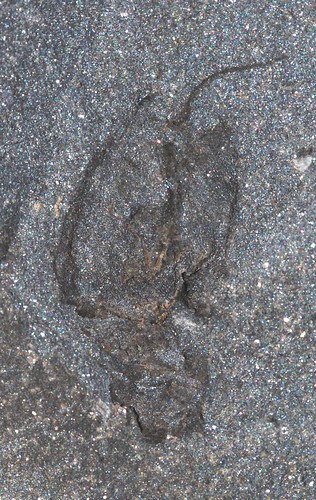There are so many weird fossils to choose from, I hardly know where to start. If you want some inferior levels of weirdness, head over to Chris Nedin's blog on Ediacarans - but let's face it, anything you can make a doily out of hasn't yet dredged the depth of utter weirditude. Mitrates, on the other hand... now they're *really* weird.
I would start by telling you what they are, but that's really part of the problem. They've got a round-ish body (the top part), covered by some big plates and with a little movable spiky bit sticking out, and then a multi-plated dangly bit that is open to interpretation. That doesn't really tell you a lot. They're part of a wider group called carpoids, calcichordates or stylophorans, depending on personal whim. Few people call them calcichordates nowadays, though - that term presupposes a certain way of thinking that is somewhat controversial. The idea is that of Dick Jefferies, of the Natural History Museum in London, now retired and sadly rather ill. Simply put, his idea is that these and their even weirder cousins (cornutes, solutes, ctenocystoids and cinctans) are the ancestors of all the groups one of the major divisions of animal life. This group is the deuterostomes, and it includes us (chordates), echinoderms (starfish, sea urhcins, etc.) and an obscure (oops, sorry Lucy!) group called hemichordates (including the graptolites, as you well know). This mitrate would then be seen as effectively a tadpole-like creature with calcite armour plating.
The hypothesis that Jefferies worked on for 40 years was intricate and beguiling, and based on exquisitely fine interpretations of the details of the fossils. Over the past ten or twenty years, however, his views have gradually lost popularity, as a result of a wide range of developments in a number of fields, and they are now believed to be a type of echinoderm.
We have long known that they're close to echinoderms. First, that skeleton that's preserved here as a mould has a structure called stereom - a honeycomb texture that is unique to echinoderms. The way the skeleton is put together, in a series of plates, is also characteristic. In fact, it really does look like an echinoderm... except it hasn't got any symmetry. That's right - none. Starfish have five arms, as you know. Most animals have (more-or-less) one mirror plane of symmetry. Carpoids don't, and that's weird.
They're not alone in their weirdness, though - there are many truly bizarre groups of extinct early echinoderms, like the helicoplacoids, blastoids, edrioasteroids, and so forth - a whole menagerie of strane symmetries and stranger structures. Although we're now pretty sure that carpoids fit in the echinoderm tree, we still don't know where to stick the branch. Some would argue the bit at the bottom of the photo is basically a stalk (and some species seem to have attached by, it dragged themselves over the sea floor with it). Others would argue it is a feeding arm (recent finds show that it had plates that opened over a groove, very like as in sea lilies). Some argue that the different groups of carpoids are entirely separate branches that have evolved independently...
We do know they're very old, extinct, and very rare. Actually, scratch that last point - we think they're just overlooked. The beastie in the picture is about 5 mm long, and that's a complete one. They're only rarely preserved complete, because they need to be buried in one go for the delicate skeleton to have any chance of survival. The individual plates, at a millimetre or so across, are easily missed. In other words, these are only "bizarre" because we hardly ever see them. But that's no fault of theirs... they were perfectly decent results of evolution. The problem is more that palaeontologists often don't look hard enough. Sometimes it makes you question our ideas about the entire fossil record... how much is sitting there, completely overlooked?
So go on - next time you're out on the hills, turn over one more rock and be prepared to squint properly.
Wednesday, 6 April 2011
Weird fossils no. 1 (yes, I've lost count)
Subscribe to:
Post Comments (Atom)


No comments:
Post a Comment